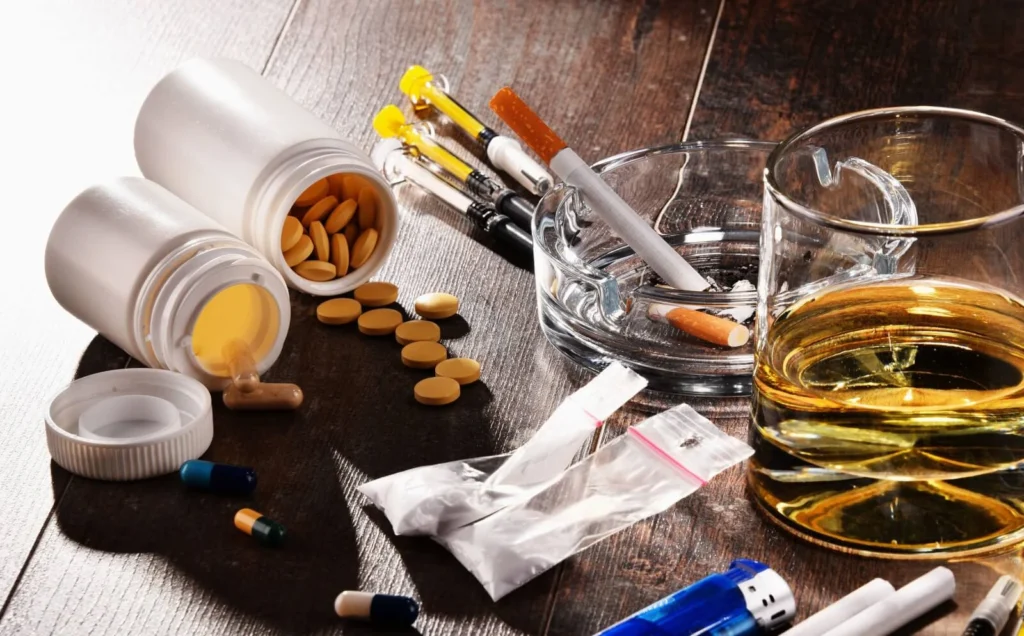Author's details
- Hakim A Abubakre
- BA (Hons) International Business Management, Msc Digital Marketing.
Reviewer's details
- Dr. Khashau Eleburuike
- MBBS (Ilorin) MSc. Global Health Karolinska Institute.
- Resident doctor in family medicine in Northen Sweden.

- Date Published: 2025-03-19
- Date Updated: 2025-03-19
Drug (Substance) Use and Alcohol Disorders
Drug and alcohol use disorders are serious conditions that involve the misuse of substances capable of altering brain functions, leading to physical, psychological, and social harm. These substances activate the brain’s reward system, which is usually activated by adaptive behaviors, such as eating or socializing. The Diagnostic and Statistical Manual of Mental Disorders (DSM-5) categorizes substance-related disorders into several classes, including:
- Alcohol
- Caffeine
- Cannabis
- Hallucinogens
- Inhalants
- Opioids
- Sedatives, hypnotics, and anxiolytics
- Stimulants
- Tobacco
Each drug class has different pharmacological effects but generally produces pleasurable feelings, often referred to as a “high.” Substance use disorders (SUD) include a range of conditions such as intoxication, withdrawal, and substance-induced mental disorders (e.g., anxiety, depression, or psychosis).
Alcohol use disorder (AUD) specifically refers to the harmful or excessive consumption of alcohol, which can range from problematic use to dependence, where a person feels they need alcohol to function.
A variety of factors contribute to the development of substance use disorders:
- Genetics: A person's genetic makeup can increase their vulnerability to addiction.
- Environmental influences: Family dynamics, social networks, and community norms can impact substance use.
- Personality traits: Impulsivity, sensation-seeking, or difficulty managing emotions can lead to substance abuse.
- Mental health conditions: Co-occurring psychiatric disorders, like depression or anxiety, are common in people with SUD.
- Societal factors: Cultural attitudes and legal frameworks define which substances are acceptable and influence people's behavior toward them.
Substance use disorders present a range of behaviors and physical symptoms, including:
- Consuming larger amounts of drugs or alcohol than intended.
- Unsuccessful efforts to cut down or control substance use.
- Spending a significant amount of time obtaining, using, or recovering from substances.
- Strong cravings to use drugs or alcohol.
- Neglecting responsibilities at work, school, or home due to substance use.
- Continuing use despite interpersonal problems caused by the substance.
- Loss of interest in activities once enjoyed.
- Risk-taking behaviors (e.g., driving under the influence).
- Increased tolerance, requiring more of the substance to achieve the same effect.
- Experiencing withdrawal symptoms when not using the substance.
Immediate medical attention is necessary if someone has used a substance and:
- Suspects an overdose.
- Exhibits altered consciousness.
- Has difficulty breathing.
- Experiences seizures.
- Shows symptoms of a heart attack (e.g., chest pain).
- Has other severe physical or psychological reactions.
Health professionals, including doctors, psychiatrists, and therapists, diagnose SUD through clinical evaluations that may include:
- Physical symptoms like weight loss, fatigue, and poor hygiene.
- Red eyes and abnormal lab results.
- Behavioral changes, such as depression, anxiety, or erratic mood.
- Abnormalities in heart rate or blood pressure.
Treatment varies based on factors like the patient's age, overall health, the substance being abused, and the severity of the disorder. The options include:
- Detoxification: The process of allowing the substance to exit the body, often under medical supervision. Medications may be used to alleviate withdrawal symptoms.
- Psychotherapy: Cognitive-behavioral therapy (CBT) and family therapy can address underlying issues contributing to substance abuse. Therapy focuses on behavioral changes and building coping mechanisms.
- Support groups: Programs such as 12-step groups provide peer support to help maintain sobriety. Group therapy can offer emotional support and encouragement.
- Medication: Some drugs, like methadone or buprenorphine for opioid addiction, can reduce cravings and withdrawal symptoms. Medications are also available for alcohol use disorder to discourage drinking.
- Long-term management: Successful treatment requires long-term follow-up, often including structured support programs and regular medical monitoring.
Substance use and alcohol disorders can be prevented through education and lifestyle choices:
- Understand how substance abuse develops: Recognize the patterns of recreational drug use and intoxication to avoid addiction.
- Avoid peer pressure: Surround yourself with people who don't misuse substances, and develop strategies to resist pressure.
- Address mental health: Seek help for mental illnesses like anxiety or depression, which often co-occur with substance abuse.
- Examine risk factors: Be aware of family history and personal risk factors, such as environmental or psychological triggers.
- Maintain a balanced life: Managing stress through healthy activities like exercise, meditation, or hobbies can reduce the likelihood of turning to drugs or alcohol.
Substance use and alcohol disorders are complex conditions influenced by various factors. Early intervention, education, and long-term treatment approaches, including therapy, medications, and support systems, are critical in managing and preventing these disorders. Recognizing warning signs and seeking help early can significantly improve outcomes for individuals struggling with substance use.
- Ogundipe O, Amoo EO, Adeloye D, Olawole-Isaac A. Substance use among adolescents in sub-Saharan Africa: A systematic review and meta-analysis. South African Journal of Child Health. 2018 Sep 17;2018(1):s79-84.
- Ebrahim J, Adams J, Demant D. Substance use among young people in sub-Saharan Africa: a systematic review and meta-analysis. Frontiers in psychiatry. 2024 Sep 11;15:1328318.
- Kugbey, N. Prevalence and correlates of substance use among school-going adolescents (11-18years) in eight Sub-Saharan Africa countries. Subst Abuse Treat Prev Policy 18, 44 (2023). https://doi.org/10.1186/s13011-023-00542-1
- Alozai UU, Sharma S. Drug and Alcohol Use (Archived). 2023 Jul 21. In: StatPearls [Internet]. Treasure Island (FL): StatPearls Publishing; 2025 Jan–. PMID: 30020635. https://pubmed.ncbi.nlm.nih.gov/30020635/
- https://www.hopkinsmedicine.org/health/conditions-and-diseases/substance-abuse-chemical-dependency
- https://www.mayoclinic.org/diseases-conditions/drug-addiction/symptoms-causes/syc-20365112
- https://my.clevelandclinic.org/health/diseases/16652-drug-addiction-substance-use-disorder-sud
